
Faculty and Student Publications
Document Type
Article
Publication Date
12-1-2021
Abstract
The oomycete Aphanomyces astaci is an emerging infectious pathogen affecting freshwater crayfish worldwide and is responsible for one of the most severe wildlife pandemics ever reported. The pathogen has caused mass mortalities of freshwater crayfish species in Europe and Asia, and threatens other susceptible species in Madagascar, Oceania and South America. The pathogen naturally coexists with some North American crayfish species that are its chronic carriers. Presumptions that A. astaci originated in North America are based on disease outbreaks that followed translocations of North American crayfish and on the identification of the pathogen mainly in Europe. We studied A. astaci in the southeastern US, a center of freshwater crayfish diversity. In order to decipher the origin of the pathogen, we investigated (1) the distribution and haplotype diversity of A. astaci, and (2) whether there are crayfish species-specificities and/or geographical restrictions for A. astaci haplotypes. A total of 132 individuals, corresponding to 19 crayfish species and one shrimp species from 23 locations, tested positive for A. astaci. Mitochondrial rnnS and rnnL sequences indicated that A. astaci from the southeastern US exhibited the highest genetic diversity so far described for the pathogen (eight haplotypes, six of which we newly describe). Our findings that A. astaci is widely distributed and genetically diverse in the region supports the hypothesis that the pathogen originated in the southeastern US. In contrast to previous assumptions, however, the pathogen exhibited no clear species-specificity or geographical patterns.
Relational Format
journal article
Recommended Citation
Martín-Torrijos, L., Martínez-Ríos, M., Casabella-Herrero, G., Adams, S. B., Jackson, C. R., & Diéguez-Uribeondo, J. (2021). Tracing the origin of the crayfish plague pathogen, Aphanomyces astaci, to the Southeastern United States. Scientific Reports, 11(1), 9332. https://doi.org/10.1038/s41598-021-88704-8
DOI
10.1038/s41598-021-88704-8
Accessibility Status
Searchable text

